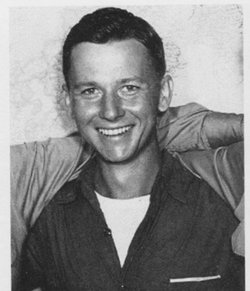BARTA-FERN
FERN JOSEPH "JOE" BARTA

RMC

SURVIVED WWII PALAWAN MASSACRE
Fern Joseph “Joe” Barta was a career Navy veteran who retired as a Radioman Chief Petty Officer. He was born February 15, 1915, in Salt Lake City, Utah, and had a difficult childhood as his father died when Barta was three years old and his mother died two years later. Historical records report he ran away from an orphanage and ended up in San Diego. At the age of 19 he joined the Navy. When World War II commenced, Barta was a Radioman Second Class stationed at the Navy Communication Center, Corregidor, Philippines. While here under attack by Japanese forces, Barta performed vital assignments under hazardous conditions for which he was later awarded the Silver Star Medal.
When Corregidor was captured by the Japanese on May 5, 1942, Barta became a POW. His first confinement was at Cabantuan POW Camp in the Philippines. He was later transferred to the Palawan POW Camp in Puerto Princesa, Philippines, where the prisoners worked over two years as slave laborers building a concrete runway using only hand tools, wheelbarrows, and two small cement mixers. When the Philippines came under attack the prisoners were forced to dig bomb shelters within the prison compound. The trenches were about five feet deep and four feet wide, each designed to hold up to fifty prisoners. In December 1944, when Allied forces were assaulting the Philippines, a message was received at Palawan reading: “At the time of the enemy landing, if the POWs are harboring an enemy feeling, dispose of them at the appropriate time.”
On December 14, 1944, as Allied forces approached, an air raid warning sounded and the POWs sought shelter in the trenches. When the prisoners were in the trenches several guards commenced to pour gasoline into the trenches followed by other guards throwing flaming torches into the gasoline. As prisoners attempted to escape the flaming trenches they were met with rifle and machine gun fire, or where bayoneted. Historical records report that secret tunnels allowed some to escape the slaughter but the Japanese searched for the escapees and killed those who were found. Only eleven POWs were successful in escaping the slaughter. Joe Barta was one of the fortunate escapees and reportedly spent ten days hiding in the jungle. While hiding he accidentally injured himself, gangrene set in, but maggots that lived in the wound kept it clean enough that he survived the disease. On Christmas Eve he was discovered by Philippine guerrillas who helped him return to American forces.
The event has been called the Palawan Massacre and records report one-hundred thirty-nine POWs were killed. The dead were buried in the trenches. In early 1945, Allied forces discovered the bodies and following the end of the war their remains were reburied in a mass grave at Jefferson Barracks National Cemetery in St. Louis, Missouri. Barta testified at a war crimes trial that led to an execution and two life sentences for a Japanese master sergeant and two officers.
Joe Barta was employed as a mail carrier following his Navy retirement and lived in Kingston, Washington, and Como, Mississippi. He died September 27, 2003, and was buried in West Tennessee Veterans Cemetery in Memphis, Tennessee. He was survived by his wife, two children, four grandchildren, and two great-grandchildren.
SILVER STAR MEDAL CITATION
The President of the United States of America takes pleasure in presenting the Silver Star to Chief Radioman Fern Joseph Barta (NSN: 3811835), United States Navy, for conspicuous gallantry and intrepidity in action against the enemy. During the period 22 March to 5 May 1942, Chief Barta and his comrades were assigned the dangerous duty of keeping the isolated U.S. Navy Communication Center, Monkey Point, Fort Mills, Corregidor, Philippine Islands, supplied with potable water. This period of approximately six weeks was one of extended frequent and intense hostile aerial bombardment and artillery fire, particularly upon the terrain over which this duty was performed. In addition it was also their additional duty to make other trips for needed provisions and supplies. The source of drinking water and supplies was located in the vicinity of Malinta Tunnel, a round trip distance of approximately 3 to 4 miles from the Communications Center. A minimum of two daily trips was required. These men never once failed to complete their scheduled daily assignments, and on several occasions narrowly escaped death when aerial bombs and artillery shells dropped in the vicinity of their vehicle. Theirs was an outstanding example of bravery and devotion to duty. They demonstrated a heroic imperturbability in a dangerous assignment. His gallant actions and dedicated devotion to duty, without regard for his own life, were in keeping with the highest traditions of military service and reflect great credit upon himself and the United States Naval Service.
Submitted by CDR Roy A. Mosteller, USNR (Ret)

